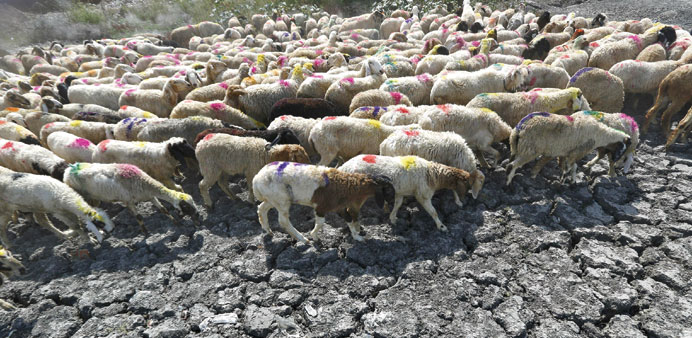A herd of sheep crosses a parched area of a dried-up pond on a hot summer day on the outskirts of New Delhi yesterday. Soaring temperatures have gripped parts of southern and northern India in an extreme heatwave which has killed more than 1,100 people.
Agencies/New Delhi
A heatwave in India has killed more than 1,100 people this week as temperatures soar above 48 degrees Celsius, and doctors’ leave has been cancelled to help cope with the sick.
May and June are India’s hottest months, with temperatures regularly pushing above 40 Celsius. But meteorologists say the number of days when temperatures approach 45 Celsius has increased in the past 15 years.
Southern India has borne the brunt of the hot, dry conditions and many of the victims are construction workers, elderly or homeless people unable to heed official advice to stay indoors.
In the worst-hit state of Andhra Pradesh nearly 900 people have died since May 18 - double the total number of heat-related deaths last summer, authorities said.
In neighbouring Telangana, where temperatures hit 48 degrees Celsius over the weekend, more than 200 people have died in the last week compared to 31 in the whole of last year.
Authorities have cancelled doctors’ leave and advised people not to head outside in the middle of the day to avoid the worst of the heat, but for many Indians, staying indoors is not an option.
“I get headaches, fever sometimes. But (if I stay indoors) how will I make money?” scrap collector Akhlaq, 28, said.
In New Delhi, forecasters said they expected the high temperatures to continue into next week - adding to the misery of the thousands of poor living on the capital’s streets with little shelter from the hot sun.
Residents of Gurgaon - a high-rise satellite city that is home to many of the capital’s workers - suffered power cuts of up to 10 hours a day as the electricity grid struggled to cope with the demand from millions of air-conditioners.
“Nothing is working - even after taking half a dozen baths a day, you can’t beat the heat,” 34-year-old shop owner Manish Singh said in Gurgaon.
“We try to spend more time indoors to avoid heatstroke. It’s worse than previous years - we hardly get any electricity and the air-conditioners become useless.”
India’s power industry has long struggled to meet rapidly rising demand in Asia’s third-largest economy, which is plagued by poorly maintained transmission lines and overloaded grids.
The streets of Gurgaon were largely deserted yesterday, while the few people brave enough to venture outdoors covered their heads to protect them from the strong sun.
Sugarcane juice stalls were doing a brisk trade as construction workers and rickshaw pullers desperately tried to quench their thirst. Elsewhere volunteers were giving out cold drinks to motorists stuck in traffic.
Brahma Prakash Yadav, director of the Indian Meteorological Department, said top temperatures in the capital would remain around 45 degrees Celsius - the national benchmark for a heatwave.
“Maximum temperatures won’t fall substantially. However, major relief can be expected from June 2 as there are indications of good showers,” he said.
Hospitals in the worst-affected states were on alert to treat victims of heatstroke and authorities advised people to stay indoors and drink plenty of water.
Hundreds of people - mainly from the poorest sections of society - die at the height of summer every year across India, while tens of thousands suffer power cuts from an overburdened electricity grid.
Eleven people were confirmed to have died in the eastern state of Odisha and another 13 succumbed to the heat in neighbouring West Bengal, where unions urged drivers to stay off the roads during the day.
One person was killed in Maharashtra, where authorities said they did not expect conditions to improve until the arrival of monsoon rains in June.
The current heatwave has been particularly deadly not only due to its high temperatures, but also due to its length.
“This increases the heat stress on the health of the person, resulting in more deaths,” Y K Reddy, Indian Meteorological Department chief for Andhra Pradesh and Telangana said.
“The heatwaves are increasing and a manifestation of global climate change,” he added.
Climate scientists note that 2014 was India’s hottest year on record, while the decade up to 2010 was the warmest for India as well as globally.
“There is already a growing frequency of extreme climatic events in India including cyclones, floods, freak hailstorms, prolonged heatwaves and droughts,” Geetika Singh from the Delhi-based Centre for Science and Environment said.
The Hindustan Times warned that some of the hot, dry conditions could plunge the worst-affected states into drought before monsoon rains arrive.

